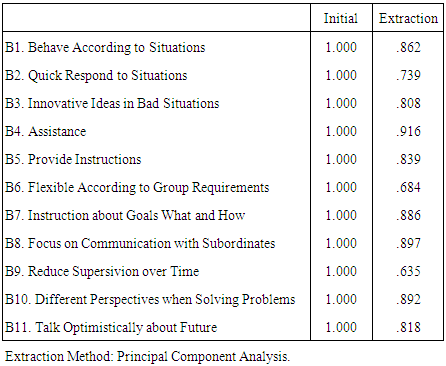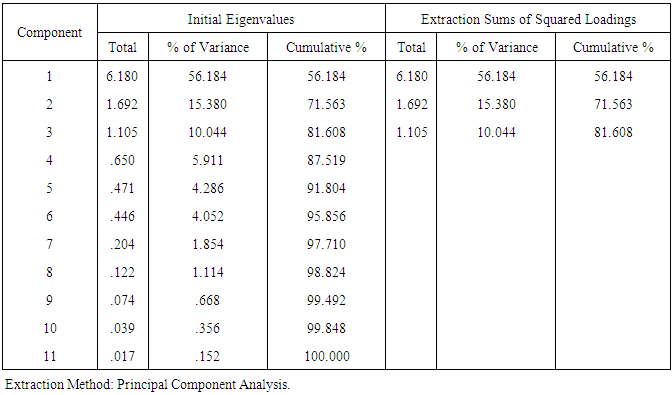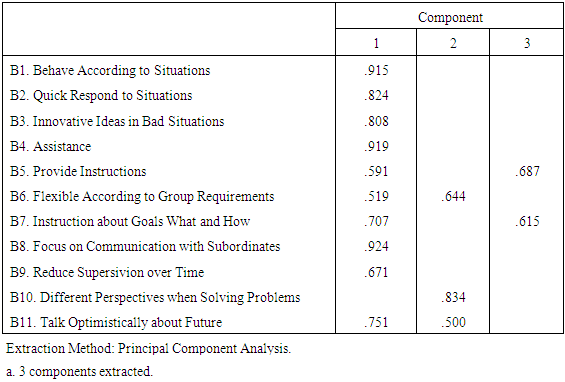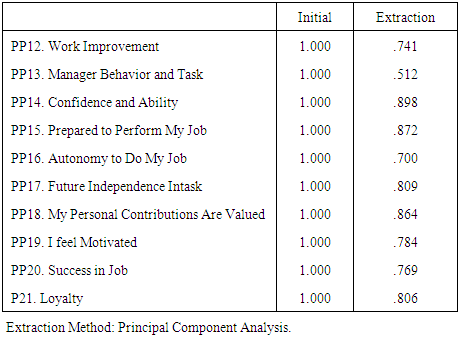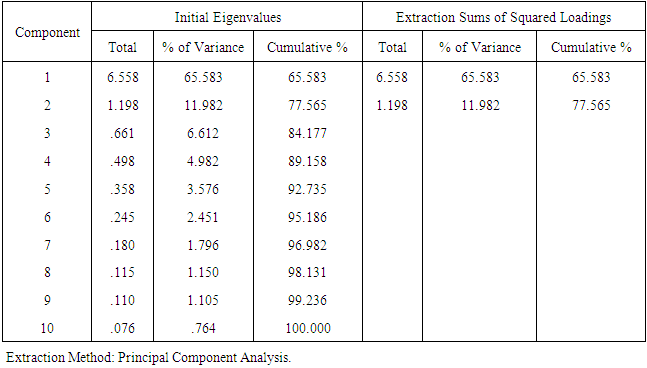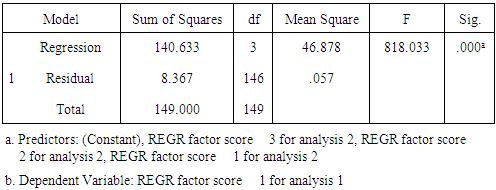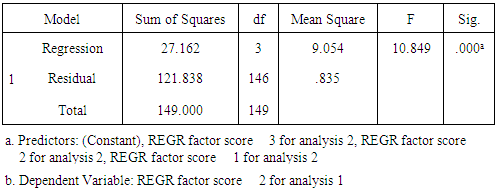-
Paper Information
- Paper Submission
-
Journal Information
- About This Journal
- Editorial Board
- Current Issue
- Archive
- Author Guidelines
- Contact Us
Human Resource Management Research
p-ISSN: 2169-9607 e-ISSN: 2169-9666
2017; 7(3): 102-110
doi:10.5923/j.hrmr.20170703.02

Situational Leadership and Its Effectiveness in Rising Employee Productivity: A Study on North Lebanon Organization
Khalil Ghazzawi 1, Radwan El Shoughari 2, Bernard El Osta 3
1Lebanese University, Lebanon
2Jinan University, Lebanon
3Lebanese International University, Lebanon
Correspondence to: Khalil Ghazzawi , Lebanese University, Lebanon.
| Email: |  |
Copyright © 2017 Scientific & Academic Publishing. All Rights Reserved.
This work is licensed under the Creative Commons Attribution International License (CC BY).
http://creativecommons.org/licenses/by/4.0/

Leadership style is a highly discussed and studied topic in the field of management due to its contribution in influencing employee’s productivity. From this perspective, this study will discuss the impact of situational leadership style on employee’s motivation. At this point, this paper is made to clarify how situational leadership affects the productivity of employees inside an organizations. A quantitative data collection approaches was used in order to study the relationship between both of these variables, were 150 participants employed at hospitals in North Lebanon filled a well-designed questionnaire to cover different aspects of situational leadership, demographic being the first part of the questionnaire, followed by situational leadership behavior of the managers, and ending with the last part of the questionnaire, employee behavior. Data collected is analyzed using SPSS, through factor reduction technique in order to unveil the relationship between situational leadership and employee productivity. As a second step analysis in this research paper, regression equation is generated to find how change in one or more factor affects the other one(s). As a final conclusion for this study, a positive relationship was found between situational leadership and employee productivity, therefore the studied hypotheses were accepted.
Keywords: Situational Leadership, Employee performance, Employee Productivity
Cite this paper: Khalil Ghazzawi , Radwan El Shoughari , Bernard El Osta , Situational Leadership and Its Effectiveness in Rising Employee Productivity: A Study on North Lebanon Organization, Human Resource Management Research, Vol. 7 No. 3, 2017, pp. 102-110. doi: 10.5923/j.hrmr.20170703.02.
Article Outline
1. Introduction
- Leadership is an interesting topic that is directly affecting the behaviors of communities, groups and followers. Many theories evolved, giving birth to different styles of leadership, and each one of these styles leads into a distinct behavior inside the organization. These studies showed that many personal characteristics are related to leadership, such as: Charisma, personal traits and behavior, and situational interaction. (Chemer, 1997) (Chin, 2015) (Marshall, 2016)Many factors could impact employees’ productivity, there can be little doubt that leadership style and behavior are considered a principle factor here. Leadership was studied for years, and proven to be responsible in affecting different organizational aspects. On the other hand, firms are tying to get the maximum possible of employees’ productivity and performance, focusing only on financial rewards, and ignoring the importance of a leader in motivating and increasing subordinates’ performance. (Sorrentino & Field, 2013)Therefore, many theories evolved in leadership, all insisted on the importance of leadership in managing employees properly. Situational leadership states that for the leader to be successful, he/she has to be task oriented and relationship oriented. Therefore this paper will focus on both work needs and employee needs and wants. (Blanchard K., 2010)This research paper investigates the effect of situational leadership style on the productivity and performance of workers at the health sector in Lebanon, covering the gap made by many previous literature reviews and empirical studies that didn’t pay attention to the importance of situational leadership style in the business world. (Shiver & Goldsmith, 2014)Research Problem This topic was chosen due to the importance of leadership and its impact on the performance of individuals inside their organizations, as for many firms lack the effective leadership style that will lead them into the desired level of productivity. More precisely, organizations are missing the necessary situational leadership practices that could affect employee productivity. This research paper is to address and lighten the spot on the importance of situational leadership to avoid serious productivity and performance problems faced by organizations in North Lebanon.Thereafter, this paper is to detect and unveil the role of situational leadership from a critical view, and typically the effect of situational leadership on productivity. From this perspective, the following problem question arises: “Does leadership style really affect the productivity of an employee, and thus the productivity of an organization?”“How can Situational Leadership help improving employees’ productivity? And what are the main situational leadership variable that affects employee productivity?”Therefore, is there a proven relationship between situation leadership and productivity of employees?”
1.1. Research Objectives
- The main research objectives are:• RO1: To investigate the need of situational leadership inside the health sector in North Lebanon • RO2: To identify the relationship between leadership style and productivity of firms• RO3: To inspect the impact of situational leadership style on the productivity of employees inside their organizations
1.2. Research Hypothesis
- The following research hypotheses are to be expected in this research:• H1a: Situational leadership Behavior will influence employee productivity H10: Situational leadership behavior will not influence employee productivity This research paper is made to test how situational leadership style is influencing employee productivity. This investigation will allow us to estimate the main situational leadership factors that heavily affect employee productivity.• H2a: Situational Leader Behavior will influence Employee’s task BehaviorH20: Situational Leadership behavior will not influence Employee’s task BehaviorThe second hypothesis is going to test one of the most important factors that characterize situational leadership which is employee’s task behavior.
2. Literature Review
2.1. The Need of Leadership in an Organization
- Throughout the course of History, leadership is considered a major factor that helps in reaching goals. Researchers like Hughes, Curphy and Ginnett (2008) said that leadership is a necessity for every action in an organization.Hersey and Blanchard (2001) said that a good leadership is going to influence employees positively and will let them work hard to achieve organizational goals. Beach (1985) said that leadership is helpful in making employees act in a direction that serves organizational goals.
2.2. Situational Leadership
- After the emergence of the trait-based leadership, situational leadership appeared as a reaction to it. Back then, social scientists believed that any person or leader is made by the result of time intervention, in other words, Karl Marx, Hebert Spencer (1884) and Carly le, said that time is the key to produce a leader. Psychologists assumed that no optimal profile for a leader exists, and no leader got the same characteristics as others. Therefore, different situations should be handled in different manner since every situation has its own characteristic. Academics built upon the search of Lewin (1935) and identified 3 types of leadership styles based upon descriptive model of leadership climate. (Milternberger, 2011). Situational leadership is a leadership theory that merges both directive and supportive dimensions, and each of these dimensions is to be applied correctly in a given situation. Leaders operating under the Situational Leadership theory have to assess their employees through evaluating their commitment to accomplish a certain task. Situational leadership means that leaders have to change the degree of supportiveness and directness to their employee according to the given situation of subordinates and their level of motivation. This type of Leadership demand that leaders vary their behavior and leadership style according to their subordinate’s commitment. (Kindle, 2009) Situational leadership is the mixture task behavior, worker commitment and relation behavior. Studies show that the success of situational leadership style isrelated to the combination of these three components must happen; it allows openness between leaders and members in addition to ensure an independence and competence in employee’s decision. A situational leader tries to discover the characteristics of his/her follower in order to know which leadership style to use with him/her. (Farmer, 2012)Moreover, situational leaders are known for giving appropriate guidance and task support for their subordinates in order to accomplish the desired goals successfully. This type of leader must also handle problems innovatively and quickly in order to overcome them. This, according to studies, is highly correlated with the improvement of employee’s productivity. (Cnaff & Wright, 2013)
2.3. Situational Leadership Models
- - Situational Contingency Model of FielderAccording to Fielder, there’s no ‘ideal’ type of leading, and therefore it would be very effective for the leader to behave according to the need created with every situation. When leaders and members are in good communication, and when harmony exists between team members, the situation is considered promising. Fielder divided leaders into two kinds: task oriented and relationship oriented. (Fielder, 2007)- Vroom & Yetton leader-situation modelThis model is known as the situational contingency model. The illustration bellow represents the situational contingency model, which shows how leaders switch behaviors and leadership styles according to situations. - The path goal theory Developed by Robert house (1971), Path-goal leadership theory is based on “expectancy theory” established by Victor Vroom. This theory states that leaders’ effectiveness is related to the degree of complementation between leaders and followers when it comes to employee’s environment to encourage good performance levels. There are 4 behaviors that complement leaders: a leader should be goal oriented, directive, supportive and participative; he/she should be as well dependent on subordinates’ characteristic and environmental factors.- Ohio State University The study of Stogdill and Coons assessed the leadership behavior instead of its own characteristics as a factor for successful leadership. These Academics defined leadership as the behaviors took by leaders to direct followers towards reaching the desired goals. The study discovered that the major factors that affect positively the relation between leaders and their followersas well as their productivity are: the nature of the relation between the leader and his follower, they named it “consideration”; his behavior is the second factor which, they named it “initial structure”, such as friendship, trust, mutual respect and the strength of the relationship. The studies were conducted in the US Navy, US air force and other important American Institutes. (Stogdill, Melvin, & Coons., 1975)They added that implementing these two kinds of perspectives in leadership will positively affect their subordinates’ productivity and performance as it encourages and motivates them towards attaining the desired goals. (Daft, Richard, & Steers, 1990)These two newly discovered leadership standpoints have influenced the upcoming leadership theories in changing their perspective and directing their studies into studying the behaviors of leaders instead of their personal characteristics.As stated by Hersey and Blanchard (2001), Situational Leadership model concludes that no unique leadership style is suitable for all situations. This is due to the fact that, leaders must meet employee’s needs and wants to ensure their satisfaction, as increased satisfaction in work, and leaders’ interest in fulfilling his follower’s interests and wants, are proven to affect employee’s productivity positively. The second reason is the leader’s need to keep up-to-date with his/her employee’s development, as his knowledge in his work increases in time, commitment to get tasks done gets stronger, and ability to perform tasks gets better. As a conclusion, the Situational Leadership Model suggests that leaders should adapt their style according to employee’s readiness and development level. (Hersey & Blanchard, 2001) Hersey added that situational leaders should be flexible, change according to situations, know how to direct and coach, and to encourage teams to participate in decision making when their readiness is high.
3. Methodology
- This research studies the impact of situational leadership on employee’s productivity. Validity measurements are insured by primary data collection using a questionnaire, whereas secondary data is used to complete the literature part by using journals and articles. The sampling technique used is the simple random technique, considering that the geographical framework of the study is North Lebanon Governorate. The questionnaire was distributed over 150 targeted respondents at 6 hospitals in North Lebanon.The questionnaire was based on Hersey and Blanchard model, which was developed mainly on the basis of older models already discussed in the literature review (such as Ohio State University Model, Contingency model, etc…) A 5-point Likert Scaling technique is used in order to ensure consistency of the results (where 1 is “highly disagree” and 5 is “highly agree”). Based on that, the questionnaire is divided into 3 parts:A. Demographic part: this part is going to cover demographic variables such as age, gender, marital status and educational status as well. B. Situational Leadership: the second part of the questionnaire emphasizes the learning and deductions from the literature review, especially from Hersey and Blanchard’s situational leadership theory. C. Productivity and employee’s performance: the third and final part is intended to measure employee’s productivity and performance, according to previous study found in the literature part.
4. Results and Findings
4.1. Reliability of the Study
|
4.2. Factor Analysis
- A factor reduction analysis was conducted using SPSS and gave us the following results: - For the Part B of the questionnaire discussing the Situational Leadership Behavior Characteristics, factor analysis indicated the existence of 3 factors.- Whereas Part C of the questionnaire discussing Employee’s Productivity gave us 2 factors.
4.2.1. Factor Analysis of Situational Behavior (Part B)
- To analyze the obtained data, a factor analysis is conducted using dimension reduction in order to identify the regression; here we should note that this factor analysis was performed while forcing the results to produce 3 dimensional factors. The results obtained are displayed in table (3) below:
|
|
|
4.2.2. Factor Analysis of Employee’s Productivity and Performance
- To analyze the obtained data, a factor analysis is conducted using dimension reduction in order to identify the regression, here we should note that this factor analysis was performed while forcing the results to produce 2 dimensional factors. The results obtained are displayed in table (3) below:Table (6) represents the variables that have acceptable extraction values. The results show that all values are acceptable since all extraction values are greater than 0.05.Table (4) represents all total variance (explained) which is another important tool in factor checking. The total variance below shows a cumulative of 77.565%.As for the employee productivity and performance (PP), 2 components are generated:
|
|
|
4.3. Regression Analysis
- - Regression 1In order to complete the analysis of this study, two regression analysis will be performed. The first regression analysis will include the 3 factors from manager’s situational leadership behavior and the 1st factor in employee’s productivity and performance section, while the second regression will also include the 3 factors of employee’s productivity in relation to the 2nd factor in employee’s productivity. The first regression analysis will be conducted between the first factor (Situational Leadership) and the second factor (Leader Flexibility); while considering factor 3 as the dependent variable and factor 1 as the independent. The results of this regression are shown below:
|
|
|
|
|
|
5. Conclusions
- It was always considered that leadership style has a very influential effect on employee’s productivity, directly impacting organizational performance. Effective leadership style motivates employees to reach desired organizational goals, promoting good leadership that leads to an increase in employee’s productivity. A detailed literature review was given, including many theories discussing situational leadership theories and previous studies conducted in this topic. It’s very critical for a firm to understand the relation between leadership style and employee’s productivity, thereafter in this research paper a thorough statistical analysis was conducted to figure out the impact of situational leadership on employee’s productivity. As a conclusion of the results, we can clearly conclude that employees working in the hospitals of North Lebanon are influenced by situational leadership behaviors of their managers, as hypotheses H1 and H2 state. This study helped in proving the hypotheses and answered the research questions, as well as helped in drawing many additional conclusions, such as the fact that situational leadership is based on the understanding of the manager to his subordinate’s needs, making them more productive.
6. Recommendations
- Situational leadership was proven to be a very effective leadership style to motivate employees in different kinds of sectors. This research paper demonstrated the relationship between employee’s productivity and situational leadership style according to the different models presented by many theorists who conducted thorough studies on this topic, especially the Situational Leadership Model of Hershey and Blanchard. Therefore, and according to the results of this research paper, we can draw the following conclusions:- According to the results obtained by this study Situational Leadership task behavior theory of Hersey and Blanchard is directly related to the improvement of employee’s task productivity. Therefore, it’s highly recommended for leaders at the studied organizations in North Lebanon to consider applying situational leadership theory, when they find that their employees’ task productivity is decreasing.- The same positive and strong correlation was given between leader’s relationship behavior, introduced by Hersey and Blanchard, from a side, and employee’s productivity in a firm from another side. Thus, leaders inside the organizations are recommended to improve their relationship behavior in order to increase employees productivity.- Leadership style, and as this study demonstrated, is a very important motivator of employees. According to the test conducted on H1, motivational level of employees and situational leadership are positively associated in Lebanese hospitals. From this perspective, a continuous adoption of situational leadership style is very important to productivity improvement of employees. - Every employee has its own characterized need, therefore, it’s highly recommended for managers and leaders in the health sector in n North Lebanon to adopt a strategy that emphasizes each individual’s need.
 Abstract
Abstract Reference
Reference Full-Text PDF
Full-Text PDF Full-text HTML
Full-text HTML
